Morocco; from Atlas to Sahara Tour, 2015 issue report
Number of species: 173 Unexpected birds: Pallid Harrier (2), Eastern Subalpine Warbler, Aquatic Warbler

As every year, in 2015 we had our early spring Moroccan tour. This issue streght from March 21st to March, 30th. As usually the tour started and finished in Marrakesh, the legenday & wonderful town known as being the «gateway to the desert» in Morocco. Day 1. The tour started with a change in the planning since we were adviced by one of our costumers that his plane was delayed for 10 hours so we had to reorganise our planning and spend some time spotting birds immediatly around Marrakesh instead of going directly to Agadir, as originally planned. That morning was finally really productive since we had time to explore some interesting locations around the city. There we could spot our first Thekla Larks of many more along the trip as well as 1 Booted Eagle, 1 Barbary Partridge singing in the fresh air of the morning and the first Algerian Shrike (a probable future split from Great Grey Shrike). Zitting Cisticolas were singing in the air while a pair of Moroccan White Wagtails were chasing insects in the short grass lands. Cattle Egrets and White Storks were also moving on the grass, looking for some casual preys. First views on Common Bulbul, Spotless Starling and Moroccan Magpie were also made along the morning and the local race of Greenfinch was also spotted in the olive groves along the road.

After some birding in the open fields we moved close to a golf course were many times it is possible to see migratory birds. We spotted some Iberian Yellow Wagtails feeding on the grass. Over the grass there was a big flock of House Martins, Barn Swallows and Sand Martins hunting insects. Some Pallid Swifts joined them but the best were 2 Brown-throated Martins flying along with them! It was a wonderful view and we were really happy with it since I didn’t expected to have the bird that close of Marrakesh, becoming a nice bonus.

The morning was still long so I decided to explore a small river some kilometers South of Marrakesh. Here small orchards are to be found both sides of the stream and a line of small cliffs face one of the side of the river. This is a place were sometimes Brown-throated Martins are nesting so we were expecting to find some of them. Well, soon after our arrival at least 3 of them were flying really low and being especially interested in some nests placed in a small afluent of the river. It was a really nice view!! Some minutes of birding around produced some other birds such as Serin, Sardinian Warbler, Common Kestrel, Blue Rock Thrush, White Wagtail, Common Linnet and Cetti’s Warbler nerviously singing in the reeds. After all costumers joined the group we finally left Marrakesh towards Agadir. After our arrival to Agadir and our check-in in the hotel(where we were wellcomed by a House Bunting singing in the roof of the hotel and some Little Swifts fluing around) still had time to enjoy a bit of nice birding. We went to the mouth of the River Souss, a superb birding spot which is inside the town itself. In the way to the mouth we spot some birds. A brief stop allowed us to see the first of many Laughing Dove as well as Great Tit, African Chaffinches and several Moroccan Magpies. In mudflats we could spot some waders: several Common Ringed Plovers, Curlews, Dunlins as well as our only one Spotted Redshank during the trip and a wonderful flock of over 40 Common Shelducks flying North over the see line. Day 2. The day start with a new change from the original planning. We were supposed to be visit the mouth of River Massa but, as it was no time in a single day to visit both River Massa and Tamri the group agreed to avoid River Massa and go for Tamri. In addition, we explore longer the mouth of River Souss that was so productive the afternoon before. We arrived to Souss River mouth’s quite early and enjoy some good staff. Flocks of Dunlins were feeding quite close from us and 2 Curlew Sandpipers were feeding along with them. At the other side of the river, an Osprey was in a pylon, quietly eating a fish while a superb flock of 7 Eurasian Spoonbills arrived to feed on the mud flats! Here and there there were Oystercatchers as there were also some Grey Plover, some of them showing already some of their beautiful summer plomage. Other shorebirds present there included Bar-tailed Godwit, Redshank, Greenshank, Green Sandpiper, Sanderling, our only one Little Ringed Plover of the trip and 2 Black-winged Stilts, the first of the year for me! There were also some Great Cormorants (nominal race) as well as Little Egrets, Grey Herons and 1 Great White Egret.

Flocks of gulls were moving up and down the river and a good roosting site was located at the other side of the river. Along with the commoner Black-headed, Yellow-legged and LBB Gulls we could spot a minimum of 7 Mediterranean Gulls and 2nd year Slender-billed Gull. Always a nice bird to watch! We scan also for Audouin’s Gulls (one of my favourites, but without luck!) In the roosting place a small flock of Sandwich Terns were sleeping and we were glad to see how a Gull-billed Tern joined the roosting flock. We walked a little bit inside the bush land to get some migrating passerines. Soon we got the firsts birds since several Subalpine Warblers were moving in the bushes. After a short walk surrounded by Subalpine Warblers some Blackcaps were appearing as well. Jerome spotted a favolous Nightingale moving in the open and flying away really fast. 4 Common Chiffchaffs and several Willow Warblers were also moving in the bushes. Along with them, some resident Sardinian Warblers were singing and it do so 2 Turtle Doves in the distant eucaliptus (we tried to find them out, but it was impossible). Finally, a female Marsh Harrier came out of the reeds to say good morning to the group and go for some hunting somewhere else. At this moment, a wonderful flock of over 90 Greater Flamingoes appeared from the sea and flought over the river mouth for a pair of minutes, looking for a place to stop. Finally, they decided to come the same way they came… After such good start we moved to some fields near the river’s mouth. There, a nice combination of salt marshes and cereal crops allows a good general birding. The area was full of Yellow Wagtails, mainly Iberian but at least 1 Italian Yellow Wagtail (cinereocapilla) was moving with them! In the fields around we counted 4 Woodchat Shrike, several groups of Common Bulbul as well as Corn Bunting and Moroccan Magpie. In the salt marshes we spot a minimum of 25 Stone Curlews roosting in the mud flats, half hidden by the tall vegetation. Around them, a flock of 9 Ruffs feeding on ground along with Wood Sandpipers and Dunlins.

After a wonderful time birding it was also time to have some nice meal. We stop in a hotel in our way to Tamri and, after having a good rest and meal, we followed our way to the top place for Northern Bald Ibises. Unfortunately, it was raining. After a quite cold morning, a small rain start to fall down about noon.

We arrived to Tamri and, after some search, we could spot a small flock of 8 individuals feeding on ground. We carefully walked to them, having care of not disturbing the birds. We enjoyed the birds for several minutes, seeing how predated over sand beetles and larvaes. Several photos and videos could be recorded. After some minutes, a new flock arrived. There were already 25 individuals in front of us!! The scenery was awesome. The brown dunes, the gentle, green slope, such endangered bird quietly moving here and there… that I didn’t disturb the group of birdwatchers telling them about a Black-eared Wheatear just close to us… It was the only appearing in the tour and I was the only one watching the bird 🙁 The rain made us move. It was getting cold and rainy so we came back to the Tamri. From the village itself we could spot 3 Peregrine Falcons. A little rain join us once more but a really short walk along fig and palm groves was really productive. A flock of Sand Martins flew off some reedbeds joined by >3 Red-rumped Swallows. In the groves around we spot several birds: 2 Cirl Buntings, 2 Ravens, Sardinian Warblers, some Goldfinches, a fast Wryneck (briefly showing in a small branch) and a wonderful flock of over 30 Spanish Sparrows preening on a little tree!

The rain became heavier so it was time to go to our hotel. That afternoon we came back to Marrakesh, having a good dinner in a fancy restaurant in Gueliz district, known as being the most attractive area of the Ville Nouveau of Marrakesh. Day 3. This day we were exploring the area around Oukaïemeden. This ski resort, placed right in the centre of the High Atlas, allows an approach to the high mountain specialties living in Morocco. Even before going inside the Atlas we had some nice birds. 2 Algerian Shrikes (a probable future split from Northern Grey Shrikes) were standing by the road showing the thin white supercilium and the buffy breast. Moroccan Magpies were all around and some Little Swifts were flying over. Not a bad start!
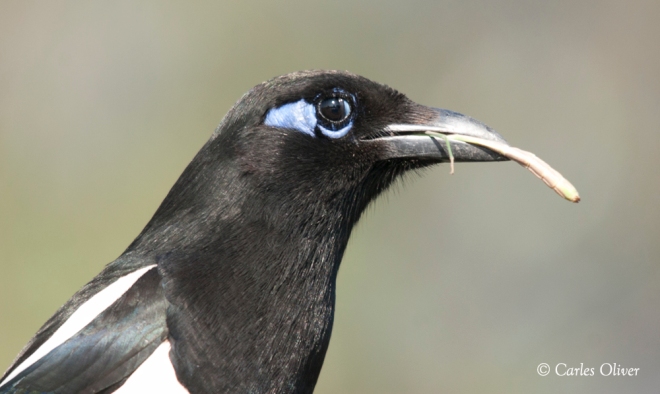
Along the road we could see some interesting birds. Anna spot what it was our already 4th Moroccan Wagtail (Motacilla subpersonata), a recent split. European Serin, Cattle Egret, Common Bulbul, African Blue Tit, Great Tit, Firecrest and Chiffchaff were also appearing. A Short-toed Treecreeper (endemic race in Morocco) was also singing around but despite our efforts to attrack it to the road, we could not properly see the bird! A second stop upper in the road was even more interesting. A flock of over 27 Red-billed Choughs were just by the road and 1 female Black Redstart was standing in a building around. We were enjoying the Choughs when a quite distant Levaillant’s Woodpecker started to call! We looked for it and we finally could locate the bird at the top of a wood pylon, showing really well! At the same moment Anna called me as she had seen something really close in the road. We all went to take a look and saw a wonderful Moussier’s Redstart just by the road, showing first on a rock, then running up and down on the grass. We were enjoying three really good birds at the same time and at that moment we would prefer to have a pair of extra eyes!
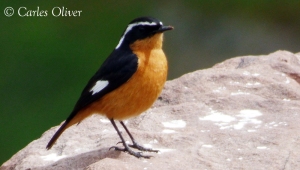
As the Levaillant’s was still calling from the same position we decided to go closer. We walked for over 200 metres and got a really better view. Then we pair attention that by the pylon a bird was standing at the top of pile of rocks. It was a male Blue Rock Thrush! It was showing briefly but still was a nice view. The Levaillant’s went away but the walk back to the car reported African Chaffinches, Serins, a female Moussier’s Redstart and House Bunting, 2. When arriving to Oukaïemeden weather conditions were quite bad. It was snowing and the fog was quite dense, with a poor light. Still, the birding was superbe! A flock of over 30 Alpine Choughs was easily located in the snow, providing really good views from the car. After a short-walk we could locate the two firsts Horned Larks feeding on ground. We kept walking for a while a good flock was located. It was, actually a mixed flock since 15 Crimson-winged Finches were with them! Despite the poor light and the cold, they allowed really wonderful views and images…

After a good time there we made a stop in the road by a stream. This area is one of the few in Morocco providing Dipper and one of our costumers from Canada really wanted to have one of this. In average conditions the bird it would appear. Unfortunately, we could not spot any of them and our efforts to find a Dipper only reported a Grey Wagtail and a Black Redstart… It was time for lunch and get some warm… the unnormally low temperatures and rainy weather we were having were challenging the tour but still we got nice views on all main birds so far!!

After lunch time a short walk in a scrub land was programmed but it had to be cancelled due to the heavy rain. It was 17:00 so we came to the hotel to have some rest and enjoy a dinner in Marrakesh famous central square later in the eve. Day 4. This day we crossed the Atlas to arrive to our first contact with the steppes and semi-deserts located immediatly South of this mountain range. A long, fascinating road leads you up by several mountain passes. Soon, weather conditions showed not as good as expected. It snowing quite heavily and traffic was slow. For a while, I was considering to come back to Marrakesh and go ahead with any alternative planning. Finally and thanks to the several tracks going up and down the road was good enough to keep going, and we crossed to the South slope. As soon as crossing the main mountain pass, weather totally changed. It was sunny and quite warm, but really windy. Some short stops in road allowed us to count over 60 Black Kites migrating North despite the huge difficulties they had due to the strong wind. A minimum of 4 Marsh Harriers were also counted.

Our first long stop was near Ouarzazate, in a location were a pair of Maghreb Wheatear was nesting that season. I saw the birds some days before so we stop and started to scan around trying to locate the birds. It was really windy, time was passing and the birds were not appearing. We spot our 2 firsts Black-crowned Wheatears and the first Desert Wheatear for the tour, but it was impossible to locate the Maghreb ones… Finally this was the only good bird not appearing in the tour. A pitty! Still, a second stop reported some good birds. In a farm land close to the place were we first stop, several Yellow Wagtails (iberiae) were feeding on ground beside some Greenfinches. Raptors were still moving North by the valley so we spot a very nice Montagu’s Harrier male and a distant Short-toed Eagle circling in the sky. But the best was a wonderful male of Pallid Harrier flying really low over the fields while flying North to get to Europe!! We were all really excited for this bird, not a common view in Morocco since most of them migrate via Turkey and Greece! Good for us!

Still, the really windy conditions made really difficult to have a good birding so we continued the road to Boulmane du Dades, expecting to have a final stop in any non-windy spot along the road. A second stop was made before arriving to Boulmane, in a good area for Maghreb Wheatear. The really strong wind made really difficult to scan around so, from the car, we could see 2 Woodchat Shrikes and 2 Desert Grey Shrikes (again a future split from Northern Grey Shrike, really easy to tell apart from Algerian Shrike!) This was the end of the day so we arrived to our hotel and had a good rest! Day 5. Early start, good breakfast and go to steppe lands aroung Boulmane to have a great day of birding! Quite early in the morning we did some stops in the steppe lands. Well from the beggining several Greater Short-toed Larks were moving in the steppes. We had really wonderful views and had also the chance to compare it with 1 or 2 clear Lesser Short-toed Larks moving also in the area (two species than can be difficult to tell apart for many birders). Still, the main goal of this early stop in the steppes was to find out the beautiful Temminck’s Horned Lark, my favourite lark in Western Palearctic. It took about 10 minutes to have the first pair moving on ground and we could all observe the wonderful combination of its sandy upper coloration, the black mask, heavily contrasting with the pure white face and the two delicate black «antenas»… always a superb bird to me!

I did a second stop in the steppe land, this time focusing on Sandgrouses (in our 2014 tour we had a flock of over 60 Black-bellied Sandgrouses plus 18 Crowned Sandgrouses here). This year we only got 2 Black Bellied Sands flying over the steppe. Still, the place reported a nice Collared Pratincole flying over the steppe vegetation moving North (migratory?), several Thekla Larks and 2 Short-toed Eagles circling in the sky and moving North. They were obviously migratory birds but still they were disturbed by a local Barbary Falcon that was trying to push them away!! The difference of sizes was spectacular to see up in the sky! A bit after we got our first flock of Cream-coloured Courser of the tour. 9 individuals quite close and showing well, running up and down in the open steppe vegetation. The strong wind from the previous day had stop but still the temperature was lower than average. Still, some migratory birds were moving. We had several Desert Wheatears as well as 1 Red-rumped Wheatear (male) and a migratory Northern Wheatear. Flocks of Common Swifts were passing by as well as Barn Swallows joined by Sand Martins. A group of 5 Black Kites was spot in the sky right before Jerome spot a bird of prey flying quite low over the steppe. After half a second it was clear that the bird was a male Pallid Harrier! The second in two days! The bird was moving quite fast (still a bit of wind…), really low and in a few seconds desappeared in an ondulation of the terrain. We all look all around trying to refind the bird, unsuccessfully!

So, we were again alone in the steppes, just joined by the group of Cream-coloured Coursers. Not a bad company, anyway! So, we enjoyed how they moved and feed on ground while (at least me) putting an eye in the sky (who knows what was next!) And the next was one Long-legged Buzzard appearing circling in the sky. It is always nice to see these raptors that, due to poissoning and hunting are scarcer year after year in Morocco. To end the morning we visited a small stream near there expecting to spot some migratory passerines. Right arriving there we got a Tree Pipit flying off the stream so I expected to find something else. No migratory birds were in the stream but a small flock of 3 Trumpeter Finch, including a beautiful male. We had excellent views on the birds drinking water and preening. In the while, 2 Red-rumped Swallows came to the stream and, after circling a bit, kept flying to somewhere else.

In the afternoon we went to spend some time in the Gorge du Dades a wonderful setting of small villages, oasis, olive groves and sandy cliffs host there a good selection of birds. We didn’t have some much time. Still, around the river itself we had a good flock of Blackcaps joined by Western Bonelli’s Warbler. Anna spot 1 Hoopoe in the farm next-by and allowed nice views on it. A brief view on Cetti’s Warbler in the riberside vegetation was a nice bonus. African Chaffinch, African Blue Tit and Sardinian Warbler joined us as well. In the way back we stop by some cliffs and had a good Black Wheatear (later we had a really wonderful one in the hotel itself). It had been a long, complete day and now was time to have a good dinner and a good rest!

Day 6. Again in the morning in the steppes, this time with strong wind (again) and looking for Thick-billed Lark that has in this area some of the few nesting places in Southern Morocco. In the way to the steppes we had our only one Seebohm’s Wheatear of the trip, a wonderful male that for sure was waiting for better weather to go back to high mountain grasslands. In the steppes, we enjoyed a Red-rumped Wheatear male but soon we spot a pair of Thick-billed Larks. They were showing really well in a small stone hill in the steppe area and seemed to be collecting nesting material on ground.

We saw the birds moving up and down from a small area beyond the stone hills. So, we moved a little bit and wait for a while, trying to discover the area where the larks were building the nest. After a small waiting a female was arriving to that area, running among the short vegetation. It was carrying what looked to be some feathers from a chicken. After some running turn left, coming directly to us and, after about ten metres the bird was stopping and getting inside its nest. We could easily see how the bird was building the nest. Behind, some Lesser Short-toed Larks were moving around. One minute or so latter the male was also arriving to nest bringing some extra feathers. It was a really wonderful view. Some minutes later we withdraw to do not disturbe the birds. After such a wonderful sight all the group was really happy so it was decided to go to the place were the Cream-coloured Coursers were seen yesterday to try to get better images. Unfortunately only five of the nine seen the day before were relocated and they didn’t allow to improve the images we took the day. In before. In contrast all the place was full of Temminck’s Larks and Greater Short-toed Larks. It was time to go to Gorge du Dades to look for one striking bird; the near-endemic Tristam’s Warbler. Inside the mountains the wind was extremely strong. We stop in some places looking for the bird but no luck. It was really little movement of small birds. Still, we had a really nice Hoopoe, several Common Kestrels, Nightingale and Black Redstart while a small flock of Common Linnets passed by. Trying to keep the group in protected places against the wind we found 2 Blue Rock Thrush (male and female) that allowed wonderful sights and images as well as 2 Rock Buntings, 1 House Bunting and Black Wheatears.

We had a lunch in the mountains and taking advantage of terrase in the restaurant we could see a good number of Crag Martins as well as Blue Rock Thrush, Grey Wagtail and African Blue Tit. Once the lunch was delaited we came to the place for Tristam’s Warbler. Weather conditions had changed quite a lot with only a soft brise moving among the rocks so I was now optimistic about finding the bird. Soon, a male was listened singing really up in the slope. We waited for some minutes and finally the bird was moving down the slope to stop immediatly below us in a small tree. It was a wonderful male showing really well and even allowing a record shot. A walk around allow us to (briefly) see a female but didn’t allow any approach.

The rest of the afternoon we explored a small gorge down the mountains. The area presents a really low, scarce vegetation and it is a really good place for a number of birds. Just after a short walk we could listen a Spectacled Warbler singing up in the hills and, at the same time, a pair of Desert Larks moved in front of us, at the other side of the stream. We scoped the Desert Larks but in the meanwhile the Spectacled Warbler was lost. Soon after a pair Black Wheatears showed really well and a small pack of 3 Trumperter Finches appeared in the gorge to feed on ground around us. Some metres beyond that place a male Moussier’s Redstart appeared for a while showing its incredible plomage but was for short and it was not enjoyed for the whole group. It was time for last stop and the target was a small decidous forest by Dades River. Here we could see Blackbirds but also 1 Woodchat Shrike, 1 Western Bonelli’s Warbler, 1 Chiffchaff, Common Bulbul and European Serin. In the way back to the hotel we had to stop in the road as 1 superb Bonelli’s Eagle flow over us to say us good by and wishing us a good trip! Day 7. Early morning start and road to the East, towards Merzouga. Before, it was time to take a small look in a gorge to try to find the secretive Pharaon Eagle Owl… without luck. Still, we have some good birds; 1 female Thick-billed Lark showing really close, 2 Desert Larks, 1 Long-legged Buzzard and a pair of Red-rumped Swallows were all seen.
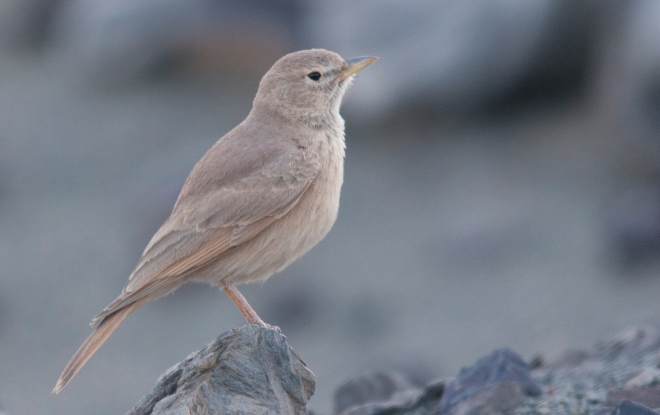
Once in the road we did some stops providing more Desert and Red-rumped Wheatears. After a pair of hours of drive we stopped in a dry river bed to look for Scrub Warbler. We hadn’t had to wait long until a gorgeous male was showing well. Singing from the top of some bush or feeding on ground around them. This is normally a really striking bird and it is sometimes not appearing when exploring the country by yourself or even in a bird trip. In the area was little movement so we came to the car as I wanted to stop in a place which is normally providing good birding on migratory passerines. We arrived there and it was really quiet. Flocks of House Sparrows were moving in the sandy palm tree orchad plus some Greenfinches here and there. There were only few birds moving in a tree just beside the path so we were there and spot 4 «Subalpine Warblers», all of them males. Taxonomic treatment of this species has been changed in the very last years so it has been recently split into 3 different species (Western, Moltonii’s & Eastern). So, what it was my surprise to see in that bush a male having all patterns of Eastern Subalpine Warbler (Sylvia albistriata). Light grey upperparts and rump, evident, well defined and wide white moustache along with strong reddish throat and breast as well as white belly and vental area. A great and unexpected sight that we could see for some minutes before but, unfortunately could not take any image of the bird!! No other birds were moving around and the heat was quite strong so we came to the car to follow the road until our hotel in Merzouga were we could have some rest, some chating about the exciting birding in the morning and to prepare ourselves for a small afternoon trip to Merzouga’s lake. That lake, placed in right beside one of the limits of Moroccan Sahara, acts as an iman for thousands of migratory birds as a mandatory stop after crossing the endless desert. Our one hour long visit to the lagoon that afternoon produced a fine selection of ducks including >50 Ruddy Shelduck showing their beauty along the shore of the lake. There were also 5 Northern Shovelers, 10 Marbled Ducks (really endangered ducks), 1 Garganey and a wonderful flock of at least 15 Ferruginous Ducks!! Small groups of Red-knobbed Coots were also feeding across the lagoon. The lake also reported some waders. We had 1 Stone Curlew, 4 Kentish Plovers and 4 Ruffs along with several Black-winged Stilts, Redshanks and Common Ringed Plovers. At least 10 Gull-billed Terns were over flying the lagoon and the Great Crested Grebes diving in. And all of this with the sandy dunes around the lagoon reflecting their colour in the flocks of Greater Flamingoes!!! The desert around the lagoon reported also 1 Nightingale, 1 Northern Wheatear, 1 Woodchat Shrike and Desert Wheatears moving along with some Greater Short-toed Larks… After such a nice selection of birds we came back to hotel to have a nice dinner a some rest! Day 8. This was our full day in the desert to look for desert specialties, some of them quite scarce or elusive. After having a good breakfast our 4×4 was waiting for us out of the hotel. Our first stop was to look for the scarce Desert Sparrow. After a short wait in a incredible setting of dunes and palm trees we spot one male arriving to the top of a small construction along with House Sparrows. It was there for some minutes, preening and showing in the wonderful morning light.

Our second stop reported us 2 Greater Hoopoe Lark, 1 Bar-tailed Lark, 1 Desert Lark, 1 Hoopoe and 1 African Desert Warbler singing in the top of a bush. We were enjoying for quite long of the bird moving up and down along the sparse bushy area while feeding on caterpillars. While enjoying the warbler a huge flock of 64 Pin-tailed Sandgrouses flew over us calling and flying towards Algeria, where they sometimes go to feed. In the meanwhile Anna spot 1 Cream-coloured Couser and a carefully scanning of the area produced 3 more to be add to our list.
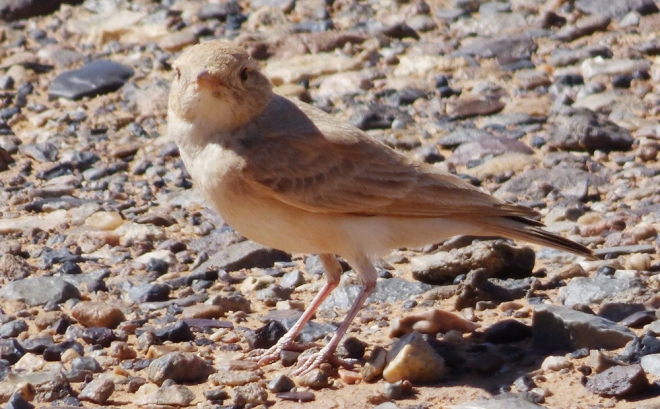
The African Desert Warbler allowed excellent images but, despite our efforts, this time we could not get close enough to the Greater Hoopoe Lark to take any nice photo. With the help of a Lahce, our local guide, leaded us towards a place where a Egyptian Nightjar can be seen roosting in the desert. It is always an amazing to see their wonderful camouflage (thought they roost on ground in the middle of the desert!) We were there for a quarter or so and quietly leave the location to do not disturb the wondeful bird that, like a sphynx, was sleeping on the sand!
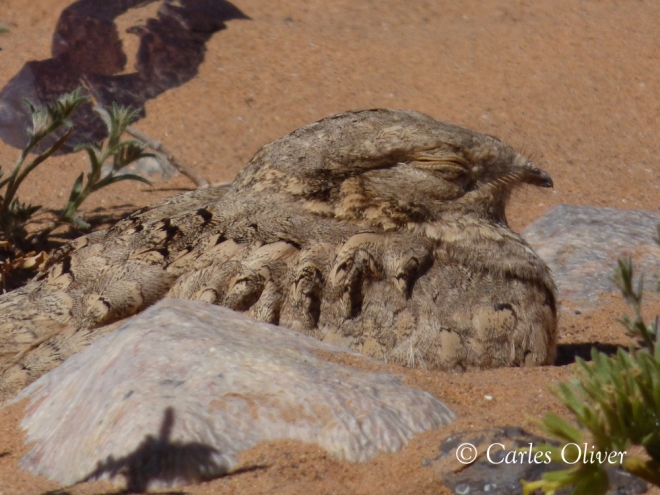
After that we had a short stop in some «farm larnds». Here we were expecting to find some migratory birds but was quite quiet. Still, 2 Maghreb Larks were appearing as well as 1 Winchat and 2 Norther Wheatears. Back to the desert a group of 4 Brown-necked Ravens showed well, but very briefly, by the road. In the «hammada» desert and after a short research we found our first pair of Spotted Sandgrouse of the trip, again allowing gorgeous views and good shots.

It was already midday so we went to Rissani to have some lunch and we kept going on to spot some more birds. The oasis and orchards around Rissani were this year extremely productive as we found a family group of at least >10 Fulvous Babblers, 2 Blue-checked Bee-eaters, >4 Maghreb Wheatears, 4 Desert Grey Shrikes and 2 Little Owls roosting along with several Laughing Doves and Common Bulbuls!!

This was right before to explore a clay cliff hosting White-Crowned Wheatear and the impressive Pharaon Eagle Owl. It took us a little bit longer than expected (we enjoyed the White-Crowneds…) but we finally had really good views on a bird sleeping in a shade of a cavity. Unfortunably this time the bird was a little bit far away and we could not have really good shots on it! While watching the bird we had a unexpected visitor since a Barbary Falcon came and stop in the cliff where the Pharaon Eagle Owl was, just hundred metres from where the owl was!! A wonderful end for a wonderful day!

Day 9. This morning we wake up with a nice flock of over 20 European Bee-eaters flying over our hotel, right beside the Erg Chebbi. This day we explored some areas for migratory birds. In our first stop we got 2 Olivaceous Warblers calling but we couldn’t get any clear view of the birds. In addition we got 1 Chiffchaff, Willow Warblers, Subalpine Warblers, 1 Squacco Heron, 2 African Wagtails and 2 Ruddy Shelducks. Later in the morning we did a stop in a small river, one of the few places with good riparian vegetation all around the area. The reedbeds were full of Sedge Warblers and European Reed Warblers. 4 Blue-cheecked Bee-eaters and small flock of Little Swifts were flying over us, really close allowing incredible views on them. Among the riparian vegetation we got a second Squacco Heron for that morning. We were checking for Crakes as this location is quite good for them. Still, we had no luck this time!

In the river we also spot 1 African White Wagtail and many Yellow Wagtails (iberiae). We were about to live when a bird moved really close in the reedbeds. We all stop and carefully scan the reeds… some seconds later we were shocked to see 1 Aquatic Warbler moving quite close to us!!! It showed well for some 5-10 seconds and immediatly after it disappeared again in the reeds!! It was a great end of our visit to this small wetland!!! Before going back to our hotel for lunch we made a final stop to try to get better views on Saharan Olivaceous Warbler. I tryed this time a different location with bigger trees and some sparse branches to give us more chances. In the area it was 1 Turtle Dove singing as well as some Moroccan Magpies, European Serin, Spotless Starling, Laughing Dove and Blackbirds. After some research I spot a bird right in front of us, singing and showing well in the sparse branches. Got it! An excellent end to our morning! In the afternoon, new visit to the Merzouga lake. We got more or less the same birds than two days before (including the flock of 10 Marbled Ducks) but we could a gorgeous flock of >30 Garganeys as well as a flock of 12 Common Pochards. A minimum of 6 Black-crowned Night Herons were also sleeping in the reeds and Greenshank and Bar-tailed Godwit were spotted in the shore.
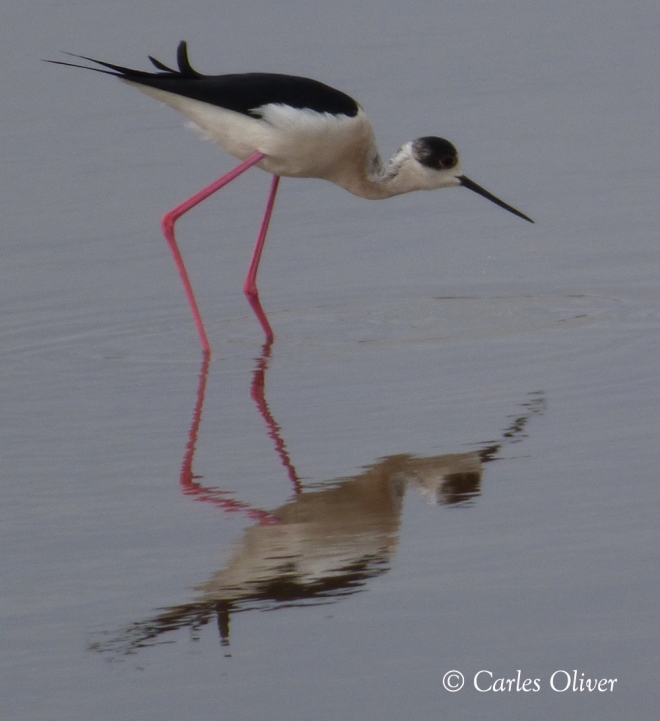
Day 10. Last day of the tour and Merzouga-Marrakesh transfer. But before we had time to visit a small cliffy area around Rissani. We only had 1 hour before start our trip back but it was enough to have a wonderful Lanner Falcon on the cliff, preening in the early morning light. In the area, a pair of White-crowned Wheatears were moving at the foot of the cliff and 1 Desert Lark was moving also in the area. We started to go back to the car when a small flock of 4 Crowned Sandgrouses passed by us showing really well. Despite the flock was not enjoyed for the whole group, it was a fantastic end for our time in the desert.

We stop a pair of times in the way back but we only got a pair of distant Bonelli’s Eagle… was during the afternoon in the Northern slope of the Atlas, in a small poplar forest. Here we spot 1 Great Spotted Woodpecker, Cirl Bunting, Common Bulbul, Hawfinch, Nightingale, Short-toed Treecreeper, African Chaffinch, African Blue Tit and Eurasian Robin. And this was the end of the tour. We are already excited about our next issue… do you feel like coming 😉

